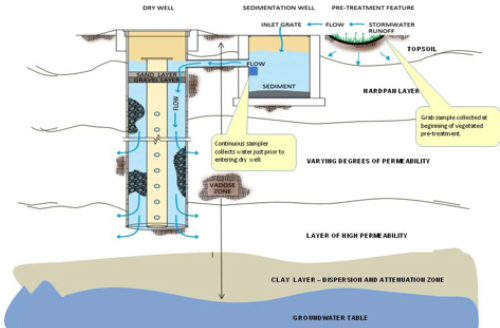During the 2014-15 and 2015-16 water years, stormwater and groundwater data were collected at the two dry well sites. Monitoring for a wide variety of contaminants was performed during the dry and wet seasons for these two consecutive years. The analysis included examining the following:
- A difference in stormwater quality before and after runoff has passed through the pretreatment features in order to evaluate the effectiveness of removing sediment from runoff.
- The differences between contaminant concentrations in stormwater as it entered the dry well, in the vadose zone, and at the groundwater water table which provided insight into contaminant sequestration in the vadose zone.
- The differences in groundwater quality upgradient and downgradient of the dry wells which helped to identify the source of contaminants in groundwater, should any be detected.
To address these concerns, stormwater and groundwater samples were collected during and after five rain events; and dry season groundwater samples were collected three times. Water was analyzed for over 200 contaminants. In addition, flow measurements were calculated and vadose zone modeling was performed to assess the fate and transport of key contaminants.
Contaminants of Interest
A wide range of urban contaminants will be evaluated in both stormwater and groundwater. The list of analytes includes:
- Total suspended solids (US EPA 160.2)
- Pyrethroid pesticides (WPCL #53)
- Chlorophenoxy herbicides (US EPA 8151A)
- Total petroleum hydrocarbons and motor oil (US EPA 8015-diesel and gas)
- Pyrogenic polycyclic aromatic hydrocarbons (US EPA 8310)
- Semi-volatile organics (US EPA 625)
- Volatile organics (US EPA 8260B)
- Drinking water metals and hexavalent chromium when indicated (US EPA 200 series)
- General physical (US EPA STDM)
- General mineral (US EPA STDM)
- Total coliform (SM 9221)
- Glyphosate (final monitoring event only)
- Turbidity
Stormwater Monitoring
Stormwater samples were collected from the first flush event and from additional consecutive rain events that produce runoff volumes of a minimum of ½ ” within a 24-hour period, for two consecutive years (total of five sampling events). Samples collection began within 2-hours of the initiation of the rain event and continue for the entire event. At each event, a flow-weighted composite sample of approximately 10 liters of stormwater was collected from the pipe that conveys water from the sedimentation well to the dry well. This sample was analyzed for the full suite of contaminants. In addition, a grab sample was also collected from the same location for measurement of conventional parameters (i.e., pH, DO, turbidity (NTU) and for a laboratory analysis of total suspended solids). An additional grab sample was collected as stormwater enters the vegetated pretreatment feature for the measurement in the lab of total suspended solids and pyrethroids. Further details of the sampling methods are included in the project’s Quality Assurance Project Plan (QAPP), Appendix 1 – Standard Operating Procedures. The diagram below illustrates where the composite and grab samples will be collected.

Dry wells system to left with stormwater sampling locations.
Groundwater Monitoring
Groundwater samples were collected from three groundwater monitoring wells and a vadose zone well at each site for the same rain events described above for two years. Groundwater levels were regularly monitored using a combination of manual and continuous measurements. During the rainy season, samples were collected approximately three to five days after each storm event to allow time for water to infiltrate through the vadose zone. The exact timing of the delayed collection was determined by monitoring well water levels after rain events.
In addition, a fourth sample was collected during the dry season from the three monitoring wells. However, there was not sufficient water at the vadose zone well to collect a sample during the dry season. Approximately 10 liters of groundwater was collected for analysis of the contaminants listed above.
For more details on the project’s stormwater and groundwater monitoring, click on icon below to review the project’s Quality Assurance Project Plan (QAPP). This report summarizes the standard operating procedures for monitoring stormwater and groundwater.

